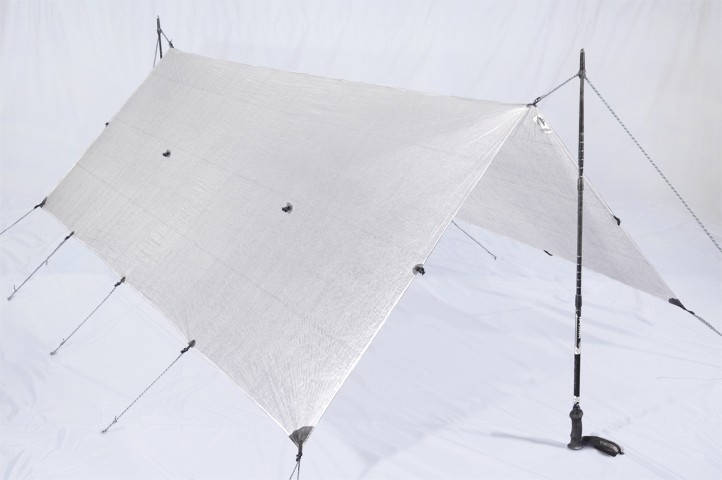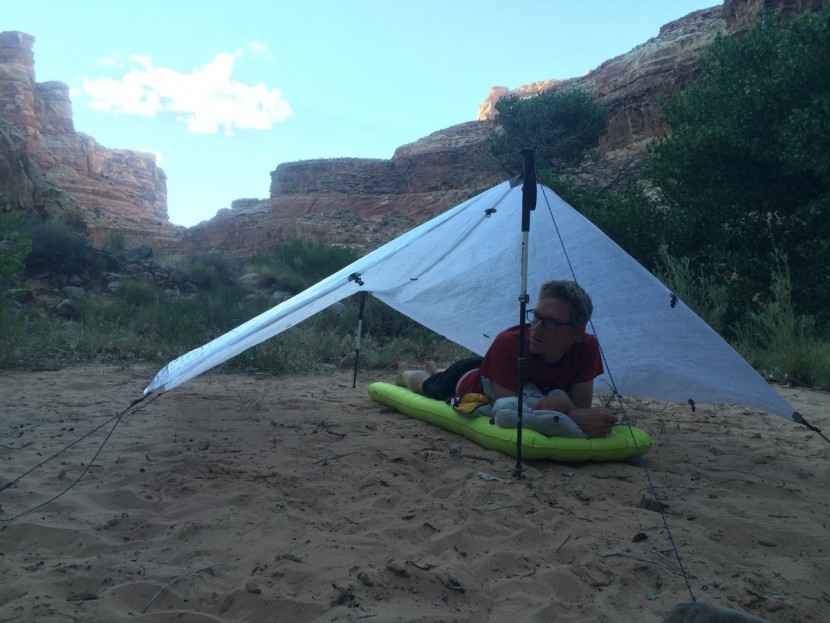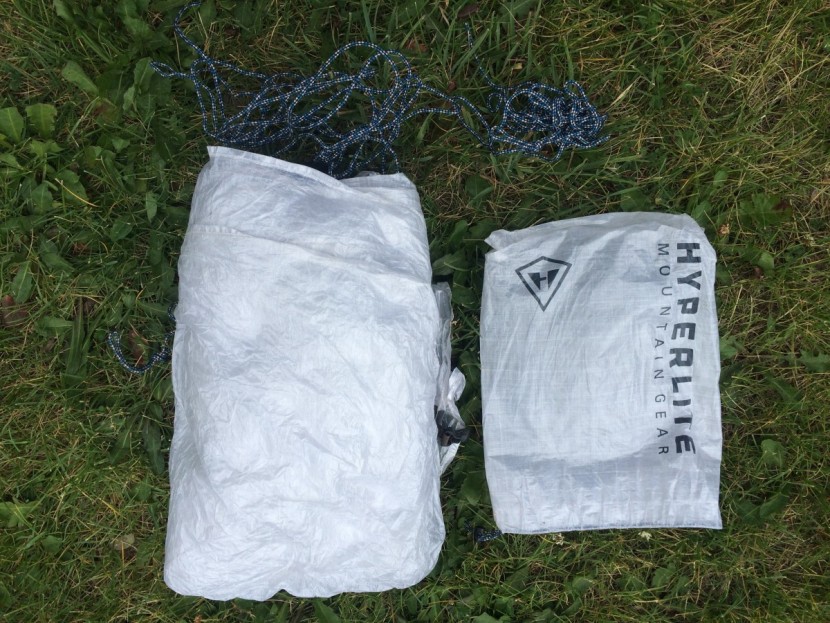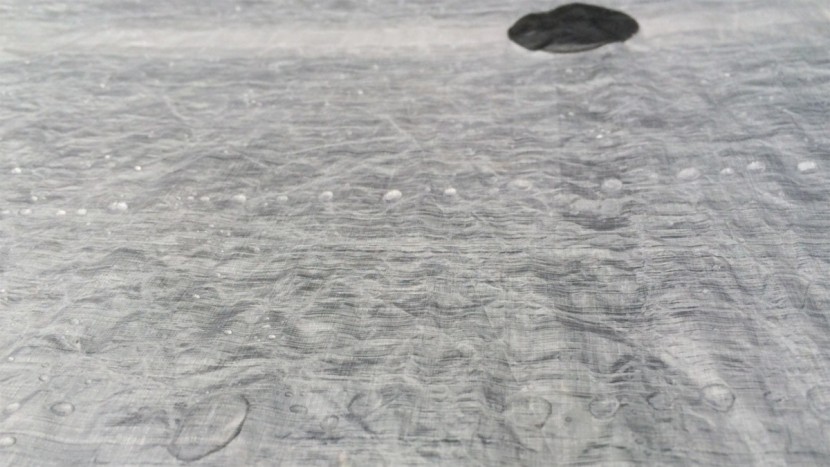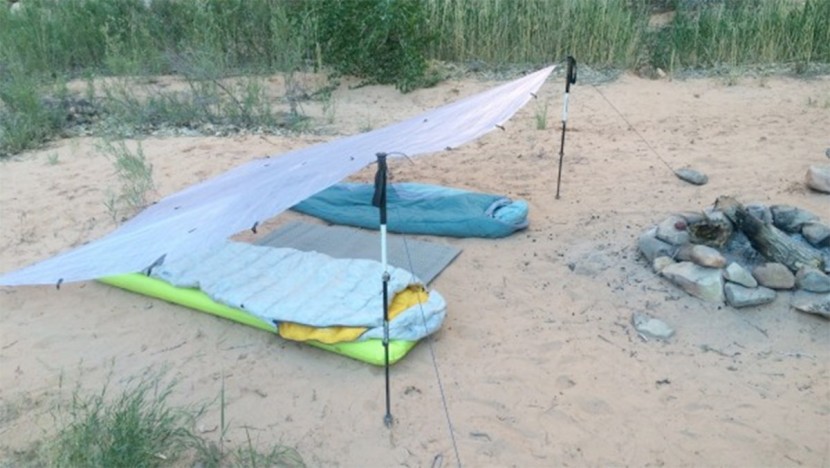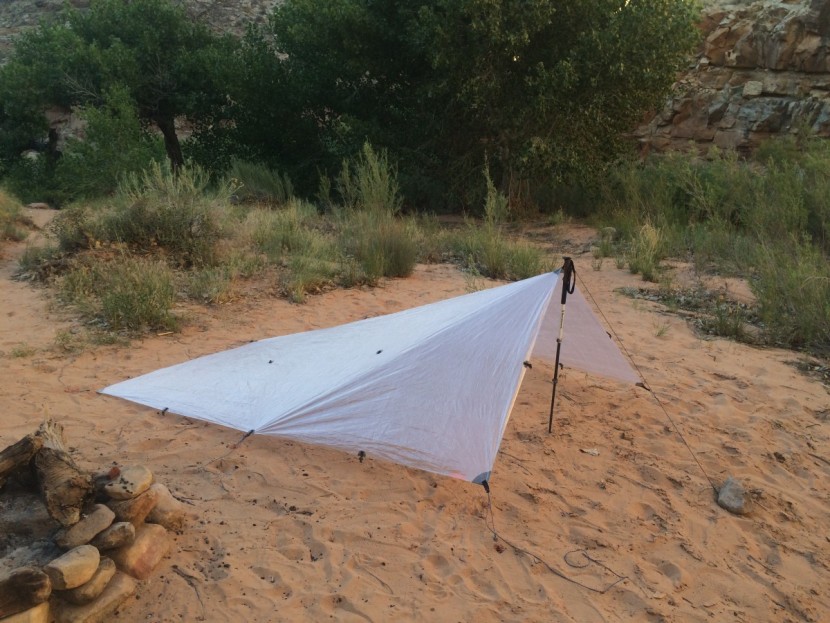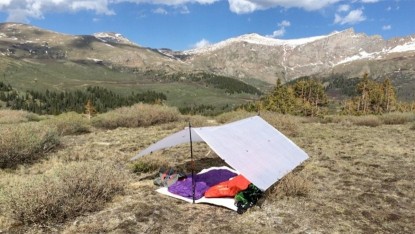Hyperlite Mountain Gear Square Flat Tarp Review

Our Verdict
Our Analysis and Test Results
The Hyperlite Mountain Gear Square Flat Tarp is a super light tarp shelter we tested and — in the hands of an expert user — defines shelter adaptability. A creative camper can pitch it for weather protection anywhere you can sit or lie down. Your adjustable trekking poles provide support for the most common pitches while adding a groundsheet or inner tent, or a bivy sack, extends severe weather protection. These great features will keep the pounds off your back and provide an adaptable shelter that fits easily in your backpack.
Livability
When pitched as an A-frame close to the ground, this flat tarp offers lots of space for two people to spread out but limited headroom for sitting up. Two D-rings along the inside ridgeline will help hold an inner tent. Storm mode offers even less room to sit up but has lots of floor space for two people and all their gear. Other configurations, such as the lean-to style, can be very comfortable and provide a fantastic view.
There is no doubt that livability is one area where using a tarp such as this one is less comfortable or luxurious than using a fully enclosed tent. When enduring a storm with the tarp pitched in storm mode, you have no choice but to lie down inside your bag, with little room to move. This tarp also doesn't have a floor, necessitating adding a ground cloth or bug protection.
For those who like a little privacy where they can change clothes or clean up after a long day of hiking, you aren't going to find it here. In short, when using this tarp as your shelter, you are, in effect, living outside in the world, and this can be a great thing or not such a great thing, depending on the weather, your needs, and your disposition. That said, these are all downsides that you'll find with any flat-tarp option.
Weight
This lightweight tarp weighs in at 0.63 pounds, including the tie-outs which come along with it and the DCF stuff sack; this makes it one of the lightest shelters in this review.
Let this be enough of an endorsement for those who value weight above all else. That said, you do need to bring your poles, which isn't captured in the weight metric above. Did we also mention how easily its small profile fits into a fastpack or backpack? Bonus points!
Weather Resistance
This tarp features the best DCF fabric that gives it ultimate waterproof-ness, meaning it won't stretch when wet and can be used in low storm mode, all in contrast to SilNylon. That said, its weather resistance depends on its pitching configuration. A-frame mode provides rain and wind protection in well-protected to moderately exposed areas (e.g., the entire Appalachian Trail and most of the Pacific Crest and Continental Divide Trails). Storm mode offers adequate protection in very exposed areas and is one of the great advantages of a flat tarp. It also features an incredible number of tie-out points. Sixteen line locks line the perimeter of the tarp, and five guy-out points in the middle (or field) offer many adaptations for the weather you might encounter. No matter how you fold or pitch it, there's likely to be a guy outpoint right where you need it!
Perhaps the most significant drawback to a flat tarp is its lack of four-sided weather protection. Storm mode protects against wind and precipitation from three sides but occasionally sprays, and wind can whip around into the entrance. In windy and wet weather, we like to seal off one side of the entry of a storm-mode pitched tarp with a full-zip rain jacket, backpack, rocks, or snow.
In the winter, you can close off one side with snow and “seal” the other (the door) with a jacket or pack. The same technique applies to an A-frame or different pitching configurations. If you want the best protection, pairing this tarp with a lightweight, water-resistant bivy sack could be your best bet. While there are plenty of workarounds to help a tarp be as weather-resistant as possible, it's never going to be as bomber as an enclosed tent, such as the issue with any tarp set-up.
Also, while it can function in certain situations in the winter, where you have a super warm sleeping bag and heated water in bottles at your feet, we find the level of protection it offers if the weather gets dire to be too much of a risk marginal. It's a much better option for most folks during the warmer seasons.
Adaptability
There is no doubt that this is the most adaptable shelter in this review. While we have mentioned A-frame mode and storm mode as the two most likely ways of setting it up for a good night's rest, many other methods exist to pitch this tarp.
Using two trekking poles, it can be set up in lean-to mode or some modification thereof, thereby making it wide enough for three. One also doesn't need to be confined to stakes and trekking poles but can use trees or branches, roots or rocks on the ground, or climbing gear (or rocks used as chockstones?) deposited in nearby cracks of rocks.
That said, we couldn't award it a perfect score regarding adaptability simply because added components will be necessary to be ready for any situation in the great wide world. It is also worth noting that set up in some ways, like storm mode, if it's windy and raining, it could be very uncomfortable to hang out in.
Ease of Set-Up
This tarp comes with ten included and pre-cut tie-outs, four of which are 6 inches long and six 4 inches long. Using these included guy-outs means you will want to carry ten stakes. As there are 16 line locks around the exterior of the tarp and five more on the field of the tarp, you will have to move the guy lines around as needed. For added versatility, you may want to add a few lengths of much longer lightweight cord to your kit for rigging to trees or other natural anchors.
The easiest way to set this tarp up is in storm mode, and this can be accomplished very quickly with one person, even in bad wind. Loosely stake out all four corners, then add the single short pole to the middle of the leeward side, and adjust as needed, adding more stakes for better security. Setting it up in A-frame mode can be trickier with only one person and requires some practice. This tarp does not have dedicated grommet holes at the ridgeline for slotting the tips of your trekking poles, so using a clove hitch is necessary. Suffice it to say that a knowledge of knots is mandatory for setting this tarp up, and the more experience you have with rigging, the easier it will be. While the set-up for the seasoned tarp sleeper isn't tough, it requires more knowledge and time than most other shelters in this review.
Should Your Buy the Hyperlite Mountain Gear Square Flat Tarp?
The Hyperlite Mountain Designs Square Flat Tarp is a lightweight, highly adaptable flat tarp shelter, making it worthy of consideration. For those who appreciate the lightness and quickness of tarp camping, this is the creme de la creme, the Cadillac, the diamond amongst tarp shelters. While it doesn't offer the same level of protection as a fully-enclosed tarp, its adaptability is one you can trust to set up anywhere. Perfect for the couple looking to go as light as possible. While the initial price is quite the investment, those that love and appreciate tarp camping through three seasons of the year will find the most value in it.
What Other Ultralight Tents Should You Consider?
Check out some other tarps in our lineup, including the Zpacks Hexamid Pocket Tarp and Kammok Kuhli UL. Both are a little lighter and easier on your wallet with less durable fabrics. If you want to move on up in the world of fully enclosed tarp tents, have a look at the Tarptent Aeon Li or the Durston X-Mid 1P Gen 2.


